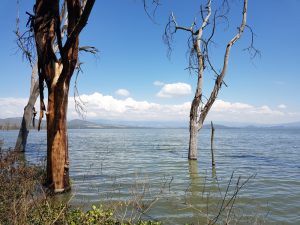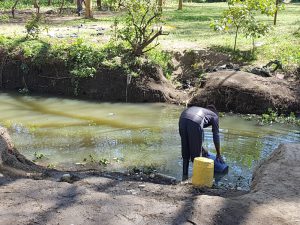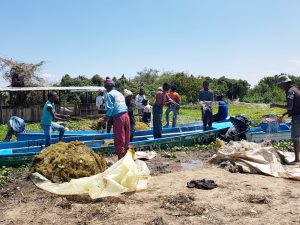by Julia Renner, University of Koblenz-Landau
“The water levels are currently enormous, but local people lack adequate provision of water!” This observation struck me during my field research around Lake Naivasha in Kenya. Therefore, enlarging the research puzzle on the water-conflict nexus, I investigate how water shortages at water abundant areas impact low-key conflicts in Kenya.
Since the early 2000s, Naivasha town and its surroundings have experienced a sharp population increase from once 100.000 people to almost one million residents now. The promise of labour has drawn many unskilled workers to the horticulture farms and hotel industry.

As a result, the population composition changed. There are two broader groups sharing the space and resources around Lake Naivasha nowadays: on the one hand, farmers, pastoralists, fishermen and descendants of white residents; on the other hand, multi-national companies and Kenyan hotel owners. Because of the seasonal variability in rainfall patterns the water levels of Lake Naivasha vary considerably. In the past, this led to conflicts between farmers and pastoralists on water usage during dry seasons. Whereas farmers mainly use water for irrigation, pastoralists rely on water for cattle husbandry. These conflicts have usually involved cattle raiding for re-stocking, cattle slaughtering or the destruction of electric fences to access agricultural land or to pave the way to the lake’s shorelines to water the cattle.
Accelerated by the population increase, the available amount of water for farmers, fishermen, and pastoralists is deteriorating. At first glance, this seems surprising given the enormous water levels at Lake Naivasha. Yet, today’s water shortage is aggravated by the chemical and waste disposal of the flower farms and the hotels. In addition, direct access to the lake becomes scarce for local residents. Supported by the political elite, national and multi-national companies are allowed to convert communal land at the lake’s shorelines into private land. The increasing economic activities around the lake reduced the number of public water access points from more than 100 to only 14. This forced most residents to move away from the lake to one of four informal settlements in the wider surroundings. They now depend on the provisions of a national water supplier, if they can afford to pay the refilling of their water tanks. Unlike the descendants of former white settlers, who were granted land titles for 99 years after independence, the water shortage affects primarily farmers and fishermen.
National and international actors turn a blind eye onto these conflicts, although the situation worsens by the day
Besides, various local conflicts around the lake can be observed, i.e. resulting from water pollution, land encroachment, upstream deforestation, unsustainable farming activities, overuse of chemicals, and increased pressure on the water access points. Most of these conflicts arise at community level. For instance, farmers construct fences around their land to stop pastoralists from grazing their cattle. Fishermen protect their landing beaches by setting up provisional fences or by night guards in order to prevent farmers from accessing water and encroaching on their land. Moreover, more forceful actions nowadays include cattle raiding and the destruction of fishing boats or agricultural land. Recently, cattle is slaughtered or people even get killed when trying to access the lake’s landing beaches.

(© Julia Renner)
There are various conflict promoting factors that exacerbate these confrontations: Farmers, fishermen, and pastoralists feel politically, economically and socially marginalized by the political elite. Lacking access to education (to escape from poverty and to increase employment opportunities), increasing population pressure, high levels of poverty and an unclear landownership system further add to the tensions. More recently, however, the limited access to water basins and unavailable or unaffordable water infrastructure become major drivers of these conflicts.
So far, this low-key conflict has not escalated into large-scale violence. National and international actors turn a blind eye onto these conflicts, although the situation worsens by the day as the water scarcity threatens the existence of many people around Lake Naivasha.
The commercialisation of Lake Naivasha’s resources, which has foremost served the economic interests of the government, further fuelled these conflicts. Whereas investors and companies need public land to establish flower farms and hotels, the local populations depend on public land to pursue farming or fishing to meet their basic needs. Governmental actors exacerbate these conflictive interests by granting companies the right to turn public land into private land. While some residents of the informal settlements are employed at the farms and hotels, others demonstrate against the companies for the right to access former public landing beaches and water access points. Strikingly, local populations challenge the investors through non-violent protest, while violence occurs only among farmers, fishermen and residents around Lake Naivasha.

(© Julia Renner)
Due to the lake’s unique setting as the only fresh water source in the area, Nairobi elites in particular support the set-up of agricultural and touristic businesses that shall contribute to the growth of the Kenyan economy. At the same time, ineffective governance structures, high levels of corruption and political unwillingness to solve socioeconomic problems also accelerate the capitalisation of land around the lake and therewith contribute to increased water shortages with severe consequences for local residents.
The contradiction of water shortages in water-abundant areas and its links to low-key resource conflicts is an interesting nexus to investigate. As I demonstrate in this article, this perspective focuses on conflictive interests between investors, the government, and the different local populations. Developing theoretical and analytical models on this nexus can support policy programs and bring the topic to wider attention of political stakeholders and scholars.

